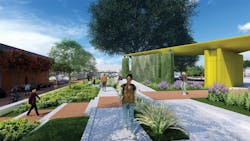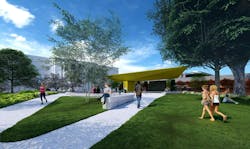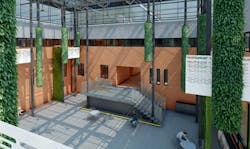During the Covid-19 pandemic, many colleges and universities experimented with outdoor teaching spaces to meet social distancing guidelines. Some discovered that these temporary creative solutions satisfied their students’ and educators’ renewed need for post-pandemic experiences and reinvigorated their campus.
The additional financial and educational benefits of permanently transforming unused outdoor areas into performative landscapes have sparked a trend in higher education design.
Environmental stimulation
“The role of the educator has evolved from the person-behind-the-lectern model to something more challenging and active,” said Brook Muller, former dean of the College of Arts + Architecture at University of North Carolina at Charlotte (UNCC).
Muller, who holds a Master of Architecture from the University of Oregon, says changing a classroom’s setting can profoundly affect pedagogy.
“There is some research that a lecture in a windowless room is less effective than an open space,” he says. “Oxygen meters show people in these enclosed spaces are getting less oxygen and retaining less information.”
After joining UNCC, Muller advocated for creating performative landscapes that fueled experiential learning and allowed for cross-disciplinary collaboration. The College of Arts + Architecture (COA+A) sought to repurpose two underutilized outdoor spaces — the Arts Quad and the Rowe Arts Courtyard.
“We have a beautiful campus landscape, but we learned during Covid that it’s not super-functional,” said Muller. “One particular pavilion was used every day during the pandemic. Students loved it. It was great to realize we could use these spaces to celebrate the creative activity of the College of Arts + Architecture.”
The UNCC Arts Quad
The new vision for the UNCC Arts Quad increases arts engagement and visibility outside the walls of the David R. Ravin School of Architecture and the Departments of Dance, Music, Theatre, and Art & Art History — creating a vibrant campus community.
The arts are engines of civic imagination providing endless opportunities to design a creative space. The design activates the exterior space with a performance stage, a new location for a performance truss, exterior seating, and perimeter zones that encourage students, faculty and staff to maximize the use of these outdoor spaces.
The Rowe Arts Courtyard
Following the completion of the Arts Quad planning, UNCC sought a new vision for the internal courtyard of the Rowe Arts Building. This ancillary courtyard, connected to the Arts Quad, will offer the COA+A a semi-conditioned space with a greenhouse roof that can open and close to regulate the temperature. It also can serve as an event venue and provide gallery opportunities and contemplative space.
Additional proposed interventions included a new entry platform, upgraded hardscape, living walls, and a tension wire grid. Balconies were added to the design to seamlessly integrate indoor and outdoor spaces.
One crucial component of the design is a fountain that supports evapotranspiration, the process that moves water from the Earth's surface into the atmosphere and produces a significant cooling effect. Adding ramps with guardrails to the design will make the sunken courtyard accessible to wheelchairs.
In addition to improving the courtyard’s accessibility, a series of bioretention edges for stormwater management addresses the environmental challenges of outdoor teaching spaces.
“It’s a very thoughtfully sited scheme that took advantage of the existing resources on the site,” Muller said.
For some universities, one of the strongest motivating factors for investing in landscape architecture is the cost.
"In addition to creating a sense of community, these projects can also minimize the cost of expanding a campus,” says Muller. “Buildings generally average $450 per square foot, while landscape architecture averages $35 per square foot. Given global supply chain issues and new construction’s effect on climate change, universities in relatively mild climates should consider alternatives because you can get a lot more bang for your buck if you can create a performative landscape.”
Boosting enrollment
Landscape architecture can also serve as a powerful recruiting tool. By taking learning outdoors, schools can give those who tour campus a glimpse of the creative learning that takes place there. For instance, COA+A plans to use the sprung floor stage in the Arts Quad for open-air performances and the upside-down U-shaped truss structure for acrobatics classes.
“Prospective students will see acrobatic students hanging from this truss as they tour the campus,” Muller says. “It’s bursting with latent potential.
Designing environments conducive to learning is nuanced. Landscape architecture is not necessarily a good fit for every discipline, but it is worth considering when seeking creative inspiration for the arts and humanities.
"Campus quads can be so much more than just outdoor places for students to spread out blankets in between classes.” says Robert Pratt, a landscape architect with Surface 678, which worked on the project. “With the right planning and design, they can become dynamic centers for experiential learning — as valuable to the student experience as a traditional classroom."
The design has brought to life COA+A’s mission to promote the arts through creative teaching and its vision to provoke thought, cultivate aesthetic sensibilities and make space for memory and reflection.
“When people seek to understand the world around them, we immediately look to the arts to make meaning,” Muller says. “It’s an empowering way to think, act, and transform because creative thinking prepares you for just about anything. Some of our alumni are artists, some went into other fields — but they’re all affecting change.”
The Arts Quad project, which is divided into five construction phases, will cost about $4 million; the Rowe Arts Courtyard about $3 million. Once completed, they will transform underused areas of campus into purposeful exterior spaces to inspire UNCC’s next generation of artists and changemakers.
Jana Hartenstine, a principal at McMillan Pazdan Smith Architecture, leads the firm's higher education practice area. She served as the 2022 Charlotte American Institute of Architects president, has juried several AIA design competitions, and held past roles with the AIA North Carolina Board of Directors.
About the Author
Jana Hartenstine
Jana Hartenstine, a principal at McMillan Pazdan Smith Architecture, leads the firm's higher education practice area. She served as the 2022 Charlotte American Institute of Architects president, has juried several AIA design competitions, and held past roles with the AIA North Carolina Board of Directors.



